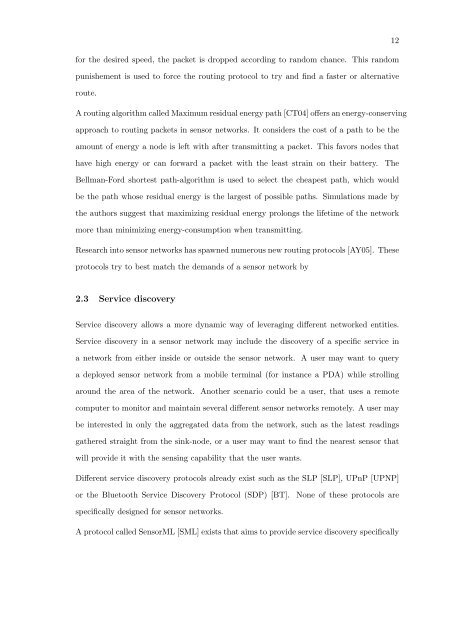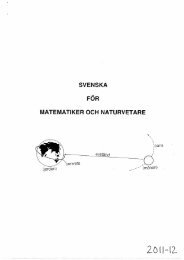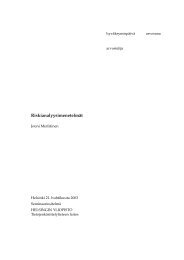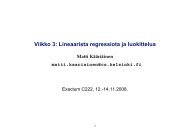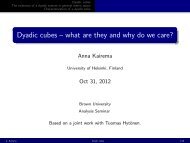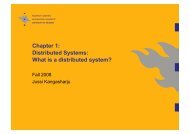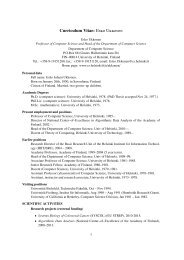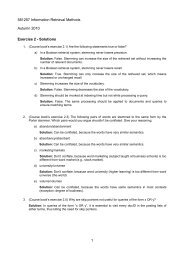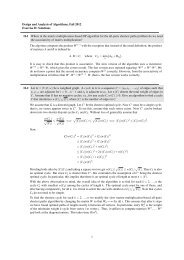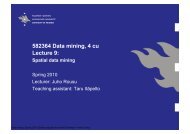Calculating trust in sensor networks
Calculating trust in sensor networks
Calculating trust in sensor networks
You also want an ePaper? Increase the reach of your titles
YUMPU automatically turns print PDFs into web optimized ePapers that Google loves.
for the desired speed, the packet is dropped accord<strong>in</strong>g to random chance. This random<br />
punishement is used to force the rout<strong>in</strong>g protocol to try and f<strong>in</strong>d a faster or alternative<br />
route.<br />
A rout<strong>in</strong>g algorithm called Maximum residual energy path [CT04] offers an energy-conserv<strong>in</strong>g<br />
approach to rout<strong>in</strong>g packets <strong>in</strong> <strong>sensor</strong> <strong>networks</strong>. It considers the cost of a path to be the<br />
amount of energy a node is left with after transmitt<strong>in</strong>g a packet. This favors nodes that<br />
have high energy or can forward a packet with the least stra<strong>in</strong> on their battery. The<br />
Bellman-Ford shortest path-algorithm is used to select the cheapest path, which would<br />
be the path whose residual energy is the largest of possible paths. Simulations made by<br />
the authors suggest that maximiz<strong>in</strong>g residual energy prolongs the lifetime of the network<br />
more than m<strong>in</strong>imiz<strong>in</strong>g energy-consumption when transmitt<strong>in</strong>g.<br />
Research <strong>in</strong>to <strong>sensor</strong> <strong>networks</strong> has spawned numerous new rout<strong>in</strong>g protocols [AY05]. These<br />
protocols try to best match the demands of a <strong>sensor</strong> network by<br />
2.3 Service discovery<br />
Service discovery allows a more dynamic way of leverag<strong>in</strong>g different networked entities.<br />
Service discovery <strong>in</strong> a <strong>sensor</strong> network may <strong>in</strong>clude the discovery of a specific service <strong>in</strong><br />
a network from either <strong>in</strong>side or outside the <strong>sensor</strong> network. A user may want to query<br />
a deployed <strong>sensor</strong> network from a mobile term<strong>in</strong>al (for <strong>in</strong>stance a PDA) while stroll<strong>in</strong>g<br />
around the area of the network. Another scenario could be a user, that uses a remote<br />
computer to monitor and ma<strong>in</strong>ta<strong>in</strong> several different <strong>sensor</strong> <strong>networks</strong> remotely. A user may<br />
be <strong>in</strong>terested <strong>in</strong> only the aggregated data from the network, such as the latest read<strong>in</strong>gs<br />
gathered straight from the s<strong>in</strong>k-node, or a user may want to f<strong>in</strong>d the nearest <strong>sensor</strong> that<br />
will provide it with the sens<strong>in</strong>g capability that the user wants.<br />
Different service discovery protocols already exist such as the SLP [SLP], UPnP [UPNP]<br />
or the Bluetooth Service Discovery Protocol (SDP) [BT]. None of these protocols are<br />
specifically designed for <strong>sensor</strong> <strong>networks</strong>.<br />
A protocol called SensorML [SML] exists that aims to provide service discovery specifically<br />
12


